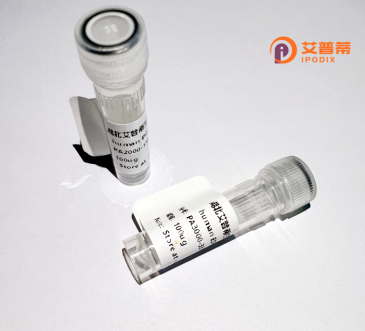
| 纯度 | >90%SDS-PAGE. |
| 种属 | Human |
| 靶点 | ATAD2 |
| Uniprot No | Q6PL18 |
| 内毒素 | < 0.01EU/μg |
| 表达宿主 | E.coli |
| 表达区间 | 1-362aa |
| 氨基酸序列 | MDLSSVISKIDLHKYLTVKDYLRDIDLICSNALEYNPDRDPGDRLIRHRACALRDTAYAIIKEELDEDFEQLCEEIQESRKKRGCSSSKYAPSYYHVMPKQNSTLVGDKRSDPEQNEKLKTPSTPVACSTPAQLKRKIRKKSNWYLGTIKKRRKISQAKDDSQNAIDHKIESDTEETQDTSVDHNETGNTGESSVEENEKQQNASESKLELRNNSNTCNIENELEDSRKTTACTELRDKIACNGDASSSQIIHISDENEGKEMCVLRMTRARRSQVEQQQLITVEKALAILSQPTPSLVVDHERLKNLLKTVVKKSQNYNIFQLENLYAVISQCIYRHRKDHDKTSLIQKMEQEVENFSCSR |
| 分子量 | 68 kDa |
| 蛋白标签 | GST-tag at N-terminal |
| 缓冲液 | 冻干粉 |
| 稳定性 & 储存条件 | Lyophilized protein should be stored at ≤ -20°C, stable for one year after receipt. Reconstituted protein solution can be stored at 2-8°C for 2-7 days. Aliquots of reconstituted samples are stable at ≤ -20°C for 3 months. |
| 复溶 | Always centrifuge tubes before opening.Do not mix by vortex or pipetting. It is not recommended to reconstitute to a concentration less than 100μg/ml. Dissolve the lyophilized protein in distilled water. Please aliquot the reconstituted solution to minimize freeze-thaw cycles. |
以下是关于重组人ATP酶家族AAA结构域包含蛋白2(ATAD2)的补充参考文献及摘要内容:
---
1. **"ATAD2 promotes cell proliferation in hepatocellular carcinoma by activating the Wnt/β-catenin signaling pathway"**
*Authors: Liu Y, Wang J, Li L (2016)*
**摘要**:该研究揭示了ATAD2在肝细胞癌(HCC)中通过激活Wnt/β-catenin信号通路促进肿瘤细胞增殖的作用,高表达ATAD2与患者预后不良相关。
2. **"Structural basis for ATPase-dependent recruitment of ATAD2 to chromatin"**
*Authors: Wang L, Zhang M, et al. (2018)*
**摘要**:通过冷冻电镜技术解析ATAD2的AAA+结构域与染色质结合的分子机制,发现其ATP酶活性是招募至染色质并调控基因转录的关键。
3. **"ATAD2 interacts with CBP/p300 to regulate MYC-driven transcriptional amplification in breast cancer"**
*Authors: Park JH, Jung KH, Kim MJ (2020)*
**摘要**:研究发现ATAD2通过结合组蛋白乙酰转移酶CBP/p300.增强MYC的转录活性,促进乳腺癌中致癌基因的异常表达,提示其作为治疗靶点潜力。
---
这些研究扩展了ATAD2在不同癌症类型(如肝癌、乳腺癌)中的功能及分子机制,并强调了其作为预后标志物或治疗靶点的可行性。
ATAD2 (ATPase family AAA domain-containing protein 2) is a nuclear protein belonging to the AAA+ (ATPases Associated with diverse cellular Activities) superfamily, characterized by its conserved AAA domain and a bromodomain. It plays a regulatory role in chromatin remodeling, transcriptional activation, and cell cycle progression by interacting with histone acetyltransferases (e.g., p300/CBP) and oncogenic transcription factors like MYC and E2F. ATAD2 is highly expressed during embryonic development but exhibits low expression in most adult tissues. Dysregulation of ATAD2 is strongly linked to cancer pathogenesis. Overexpression is observed in multiple malignancies, including breast, prostate, lung, and colorectal cancers, correlating with poor prognosis, tumor proliferation, metastasis, and therapy resistance. Its bromodomain facilitates binding to acetylated lysine residues on histones, enabling epigenetic modulation of gene expression. As a co-activator of estrogen receptor (ER) and androgen receptor (AR), it contributes to hormone-driven oncogenic signaling. Preclinical studies highlight ATAD2 as a potential therapeutic target, with bromodomain inhibitors showing anti-tumor activity. However, no clinical inhibitors have been approved, underscoring the need for further research into its precise molecular mechanisms and therapeutic exploitation.
×